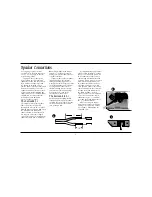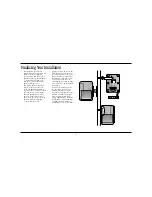
Speaker Connections
Use 18-gauge speaker wire or
electrical “zip” cord for runs up to
50 feet. Use 16 gauge or heavier
wire for longer runs.
To prepare the speaker wires,
first separate the two insulated
conductors at the end of each wire
for a distance of about one inch
(as shown in
A
, below). Then
remove about
1
/
2
inch of insulation
from each conductor. Twist the
exposed strands of each wire into
a tight spiral. Before making any
connections, be sure no individual
strands of wire short across the
terminals of your amplifier,
receiver or the speakers.
The Surround 5.1
The stripped ends of the speaker
cable can be inserted directly
through the holes in the speakers’
binding posts, as shown in
B
. Turn
the red and black connectors
counter-clockwise until the holes
are exposed, insert the stripped
ends of the cables, then tighten the
connectors back down (clockwise).
5
Note:
finger-tighten the connec-
tors only — using pliers could
damage the plastic connectors or
strip their threads.
If your speaker cables terminate
in banana plugs, insert them
through the binding post holes,
which will permit the speaker unit
to fit flush against a wall. Do not
over tighten the connectors. If
flush-mounting isn’t necessary,
you can insert the banana plugs
directly into the ends of the
speaker units’ connectors.
The Surround II 5.1
Push down on the spring-loaded
terminal tabs to expose the connec-
tor holes. Insert the bare wires into
the holes and release the connec-
tors, as shown in
C
.
It’s important that you connect
speaker pairs identically, so that
they are electrically in-phase. All
two-conductor speaker cable is
coded along one conductor with
lettering, with a stripe or a raised
bead–or–the appearance of the
two conductors differs, usually
one copper and one silver. On
each speaker, connect the cable’s
coded conductor to the red termi-
nal and the blank conductor to
the black terminal. At each
speaker output on your amplifier
or receiver, connect the coded
conductor to the “+” terminal
(red) and the blank conductor to
the “–” terminal (black).
While reversing the connec-
tions on one speaker will do no
damage, the speakers would be
out-of-phase, diminishing the
surround effect.
1"
1/2"
B
C
A





























